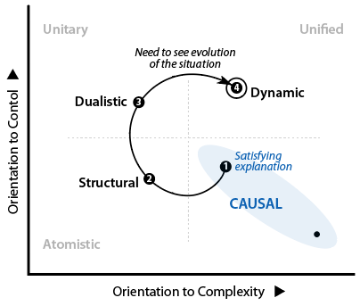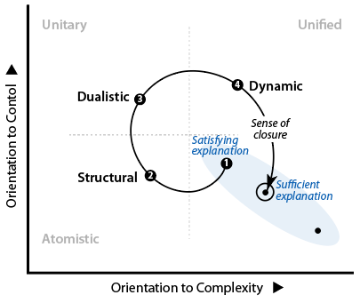Stage-4: Dynamic Evolution
![]() Reminder of the clarification process so far:
Reminder of the clarification process so far:
Understand the Dynamic Evolution
Everything so far has been static. The simple resembles an if-then hypothesis with a more or less satisfactory evidential base. The provides for an overview of a static order. If supported by detailed descriptions or facts and figures with infographics, then it is likely to be dry and dense as well. The addition of reflects enduring psycho-social differences and sets up protagonists and antagonists, and while these actors will affect evolution of the situation the "how" is unspecified.
Social situations are inherently dynamic. Components of the situation, individuals and groups, have relationships that develop and their views and actions are affected by feedback. Influences and pressures get brought to bear on choices, and there is also a context that has a variable impact and may need handling. The operation of these various forces developed the situation to its present state and can be expected to shape its ongoing evolution.
In order to capture the dynamics of evolution, a narrative is required. Elements of this narrative have been provided in previous Stages. Now a time dimension is added. The inclusion of relationships and forces ensures the narrative can be emotionally relevant and meaningful for each individual component. Narratives also encourage identification by listeners, which can powerfully influence acceptance of explanations.
Values & Assumptions

Promoting Acceptability
![]() Desired Benefit: Maximum Realism
Desired Benefit: Maximum Realism
![]() Means: Interactions and Feedback
Means: Interactions and Feedback
Handling the Group
![]() Participation: Respond to Questions
Participation: Respond to Questions
![]() Communication: Structure a Narrative
Communication: Structure a Narrative
![]() Individualization: Create Scenarios
Individualization: Create Scenarios
Channeling Your Functioning:
In Stage-3, the modelling of purpose in relation to policy-making had generated a triangular pattern: two forms of priority that interact and govern a strategic objective. Priorities determine resource allocation and the choice of strategic objective is dependent on resource availability.
There are evident interactions and influences at play in this pattern. The nature of priorities are that they assert relative importance and affect resource allocation. The personal-emotional priority strives to impose itself on the logically comprehensive set of priorities. The need for logic and comprehensiveness can restrain emotional excesses while allowing the personally preferred priority to be a focus. The two forms of priority independently shape the strategic objective.
The comprehensive set of priorities orders outcomes, while strategic objectives aim to realize the comprehensive set of priorities. The emotional over-riding priority selects particular outcomes as preferable and pushes for the strategic objective to be designed to suit.
These descriptions can be further elaborated by including effects on and from the tactical objectives below, and effects from and on the principal object or mission above. In other words, a complete account of how purposes operate must now be provided for maximum realism in relation to the use of purposes.
Stopping at this Stage

The situation has now been well-clarified in all features judged crucial. The initial has been extended through fitting into a suitable , activated through its underlying , and put in perspective via an that reveals inner workings of the situation, including the power of feedback and the effect of context.
At each Stage, the explanation has definitely become more satisfying and seemingly more satisfactory as well. So there is a sense of closure by . This allows a spontaneous re-entry into the , but lower down in the ellipse because significantly more factors have been identified and included.
The seemingly can now be described as a seemingly .
In many cases, stopping at this Stage will be felt to be appropriate.
- Re-enter the Causal Mode but further down the ellipse.
Originally posted: 30-Oct-2024